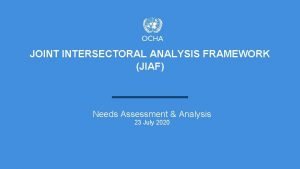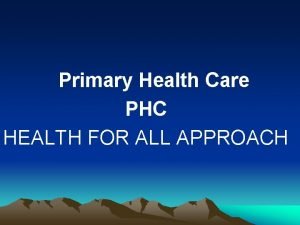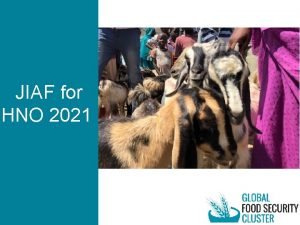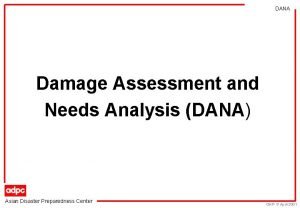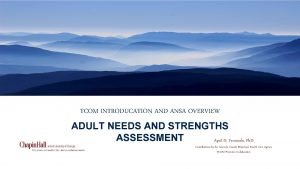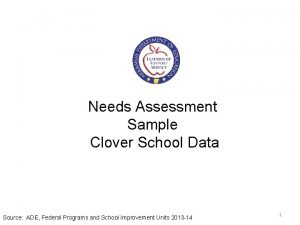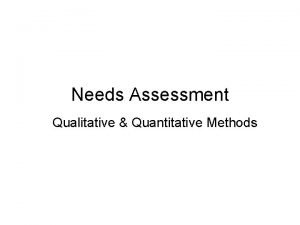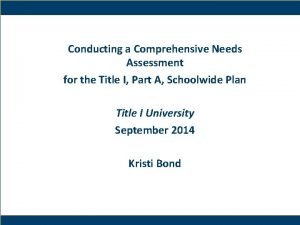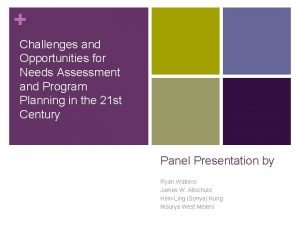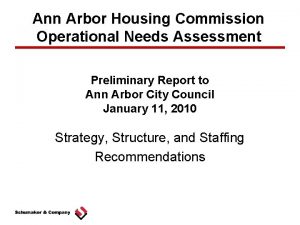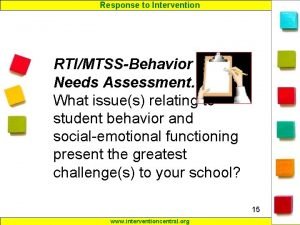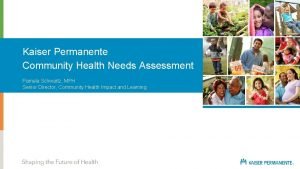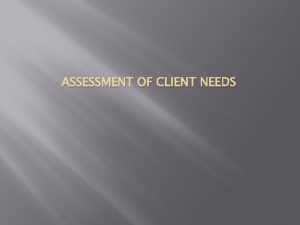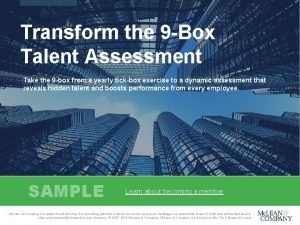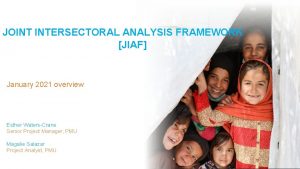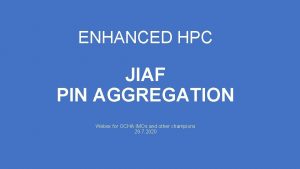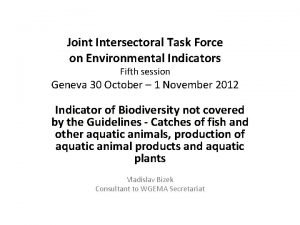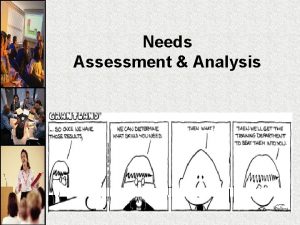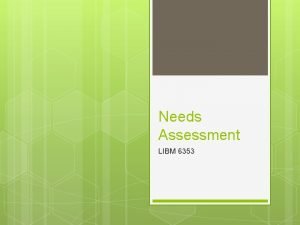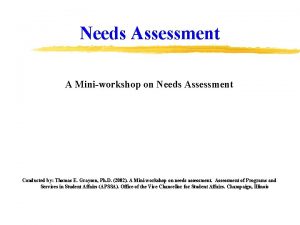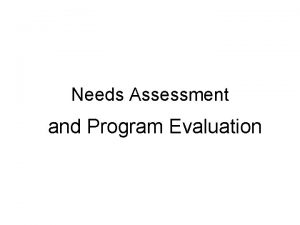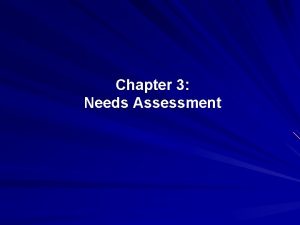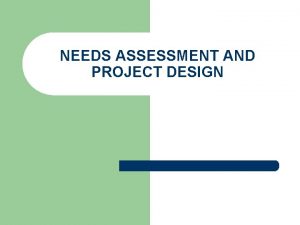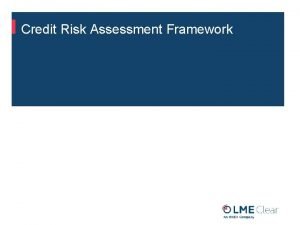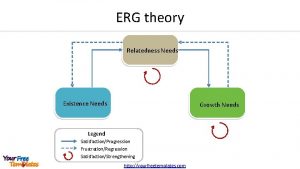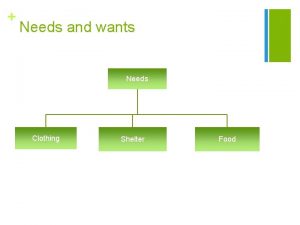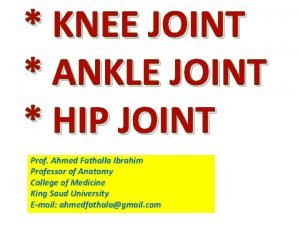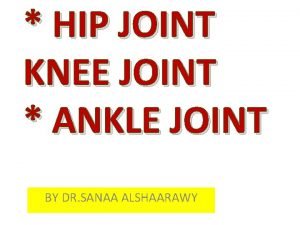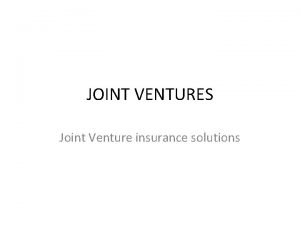JOINT INTERSECTORAL ANALYSIS FRAMEWORK JIAF Needs Assessment Analysis



























- Slides: 27

JOINT INTERSECTORAL ANALYSIS FRAMEWORK (JIAF) Needs Assessment & Analysis 23 July 2020

2021 Joint Intersectoral Analysis Framework: Agenda Intro Opening Review of process / political landscape; degree of ‘finality’ Structure of guidance Introducing the JIAF The Concepts /components How they fit together Step-by-Step Annex descriptions Conceptual Framework Definitions, examples Key differences from last year Severity scale and the indicator reference table JIAF Step-by-Step (overview) Planning, designing etc Gathering, collating data Telling the story Joint Analysis + Pi. N Risk Analysis and Projection Expert Judgement Elicitation Limitations of the JIAF Agnes / Herbert Marcus Timing 5 m 10 m Herbert 15 m Herbert Marcus 10 m 20 m Herbert 10 m 5 m

Guidance 1 2 Updated HPC Step-by-Step: • key steps • roles and responsibilities • sequence of the needs analysis and planning JIAF Guidance for HNOs 2021: • Key considerations and steps for HAOs, IMOs, analysts, ICCG, sector focal points etc involved in joint needs analysis

Guidance 3 4 Complementary guidance • Risk Analysis and Projections • Response Analysis • Disability Inclusion • Gender Analysis Annotated Templates • HNO • HRP

Structure of JIAF Guidance 1. 2. 3. 4. 5. Introduction Overview Approach Step-by-step Annexes

Guidance Structure Section 1: Introduction • • What is the JIAF Why is it important What are its limitations Its origins Section 2: Overview • What are the key questions it tries do answer • The conceptual framework

Guidance Structure Section 3: Approach • Principles guiding the process • Building technical consensus • Applying analytical standards • Joint-intersectoral analysis of context, shocks and impacts • Severity of Humanitarian Conditions and contributing factors

Guidance Structure Section 4: Step-by-step • Plan & design a joint inter-sectoral analysis process • Collating and collecting data for JIAF • JIAF Analysis • Validation of current and forecasted needs

JIAF Conceptual Framework • The JIAF is built around five pillars • each contains different subpillars. • This serves to organize information, visualize relationships and bring a consistent structure to the analysis. • The JIAF Conceptual framework helps frame the story of a population affected by a shock in a consistent and comprehensive manner.

CONTEXT: Relevant characteristics of the Area Of Interest • General characteristics of the political, socio-cultural, economic, legal & policy, technological, demographic, security, infrastructure and environmental conditions. • Example: • Remittances contribute 10% to the GDP of S Sudan …. • Roads outside the capital are unpaved … • Livelihood zones, mobile coverage, etc.

EVENT / SHOCK: An event/condition that disrupts the functioning of a community or society and causes human, material, and economic or environmental losses. • should be localized geographically as to allow an estimation of the number of people living in the affected area, as defined in the 2016 IASC Humanitarian Profile Support Guidance. • Examples: • Conflict within the line of contact; intensity, extents • Earthquake – magnitude, exposure, extents

IMPACT: The primary effects of the event/shock on the population, systems and services in the affected area • • • Impact on people - losses and damages to assets and capital, displacement, violence, mobility issues and livelihood, etc. Impact on systems - damages to infrastructure or means of communication, disruption of social cohesion, markets, services, etc. Impact on humanitarian access -obstacles or challenges for People in Need to access relief actors, for relief actors to access People in Need and other physical constraints.

HUMANITARIAN CONDITIONS: • The consequences of the shock’s impacts on the population • identified in magnitude, analyzed in terms of severity.

HUMANITARIAN CONDITIONS: The severity of Humanitarian Conditions is estimated by taking into account three levels of consequences: • Living standards: Ability of the affected population to meet their basic needs for essential goods and services. • Coping mechanisms: Degree to which people are coping or facing challenges with impact recovery. Coping mechanisms can be positive or negative. • Physical and Mental Wellbeing: Measured by assessing the physical health of the affected population as well as its mental wellbeing, excess morbidity or mortality, malnutrition, psychosocial trauma, grave human rights violations.

HUMANITARIAN CONDITIONS: • Severity for the HC Pillar is SEVERITY OF NEED, PEOPLE IN NEED 1. LIVING STANDARDS 2. COPING MECHANISMS 3. PHYSICAL & MENTAL WELLBEING 1 2 3 4 5 aggregated, distributed across the population at the units of analysis and the crisis level • Severity is ‘thresholded’ to establish Intersectoral Pi. N • Sub-Pillar Pi. N is not recommended / endorsed due to the interrelated nature of the sub-pillars

Humanitarian Conditions: Subpillar Relationships: SHOCK IMPACT 1. 2. COPI NG MECHANISM S LIVING STANDARDS PHYSICAL & MENTAL WELLBEING 3. • The Humanitarian Conditions subpillars are all interrelated. • The JIAF analysis is framed within an ‘analysis period’ for a given crisis, and for this analysis period, the unit of analysis is geographic areas and affected populations (sub-district, IDPs for example). • The Humanitarian Conditions Subpillars can (but not always) be seen as a cycle, following a shock and its impact: • From having no problems, to having some issues with addressing basic needs, to engaging in increasingly negative coping strategies, ultimately leading to negative effects on their wellbeing. • Feedback loops within one pillar, or between two can also be present – the progression is not always circular as described and many processes can be occurring simultaneously.

THE JIAF SEVERITY MODEL JIAF SEVERITY SCALE REFERENCE TABLE • Measuring intersectoral severity is a central function of the JIAF • Achieved by applying the JIAF severity model, supported by the set JIAF Severity Scale • All the indicators used in assessing the Humanitarian Conditions are scaled. • The scales refer to the definitions overall seen here. • When executed to its fullest potential, the methodology enables distribution of the 1 total number of people in an area or affected group across the five severity classes. Severity Class Name 1 2 Key reference outcome • Se None / Minimal • Living Standards are acceptable (taking into account the context): possibility of having Stress • Living Standards under stress, leading to adoption of coping strategies (that reduce ability some signs of deterioration and/or inadequate social basic services, possible needs for strengthening the Legal framework. • Ability to afford/meet all essential basic needs without adopting unsustainable Coping Mechanisms (such as erosion/depletion of assets). • No or minimal/low risk of impact on well-being. to protect or invest in livelihoods). • Inability to afford/meet some basic needs without adopting stressed, unsustainable and/or short-term reversible Coping Mechanisms. • Minimal impact on well-being (stressed physical/mental well-being) overall. • Possibility of having some localized/targeted incidents of violence (including human rights violations). 3 Severe • Degrading Living Standards (from usual/typical), leading to adoption of negative Coping Mechanisms with threat of irreversible harm (such as accelerated erosion/depletion of assets). Reduced access/availability of social/basic goods and services • Inability to meet some basic needs without adopting crisis/emergency - short/medium term irreversible - Coping Mechanisms. • Degrading well-being. Physical and mental harm resulting in a loss of dignity. 4 2 3 5 Extreme 4 5 Catastrophic • Collapse of Living Standards, with survival based on humanitarian assistance and/or long term irreversible extreme coping strategies. • Extreme loss/liquidation of livelihood assets that will lead to large gaps/needs in the short term. • Widespread grave violations of human rights. Presence of irreversible harm and heightened mortality • Total collapse of Living Standards • Near/Full exhaustion of coping options. • Last resort Coping Mechanisms/exhausted. • Widespread mortality (CDR, U 5 DR) and/or irreversible harm. Widespread physical and mental irreversible harm leading to excess mortality. • Widespread grave violations of human rights. Potential Response objectives Building Resilience & Supporting Disaster Risk Reduction & Protecting Livelihoods & Preventing & Mitigating Risk of extreme deterioration of Humanitarian conditions Saving Lives & Livelihoods Reverting/Preventing Widespread death and/or Total collapse of livelihoods

THE JIAF SEVERITY SCALE REFERENCE TABLE Severity Class 1 Name Key reference outcome None / • Living Standards are acceptable (taking into Minimal account the context): possibility of having some signs of deterioration and/or inadequate social basic services, possible needs for strengthening the Legal framework. • Ability to afford/meet all essential basic needs without adopting unsustainable Coping Mechanisms (such as erosion/depletion of assets). • No or minimal/low risk of impact on well-being. Potential Response objectives Building Resilience & Supporting Disaster Risk Reduction

THE JIAF SEVERITY SCALE REFERENCE TABLE Severity Class Name Key reference outcome Potential Response objectives 2 Stress • Living Standards under stress, leading to adoption of coping strategies (that reduce ability to protect or invest in livelihoods). • Inability to afford/meet some basic needs without adopting stressed, unsustainable and/or short-term reversible Coping Mechanisms. • Minimal impact on well-being (stressed physical/mental well-being) overall. • Possibility of having some localized/targeted incidents of violence (including human rights violations). Supporting Disaster Risk Reduction & Protecting Livelihoods

THE JIAF SEVERITY SCALE REFERENCE TABLE Severity Class Name 3 Severe Key reference outcome Potential Response objectives • Degrading Living Standards (from usual/typical), Protecting leading to adoption of negative Coping Mechanisms Livelihoods with threat of irreversible harm (such as accelerated & erosion/depletion of assets). Reduced Preventing & access/availability of social/basic goods and Mitigating services Risk of extreme deterioration • Inability to meet some basic needs without of Humanitarian adopting crisis/emergency - short/medium term conditions irreversible - Coping Mechanisms. • Degrading well-being. Physical and mental harm resulting in a loss of dignity.

THE JIAF SEVERITY SCALE REFERENCE TABLE Severity Class 4 Name Key reference outcome Extreme • Collapse of Living Standards, with survival based on humanitarian assistance and/or long term irreversible extreme coping strategies. • Extreme loss/liquidation of livelihood assets that will lead to large gaps/needs in the short term. • Widespread grave violations of human rights. Presence of irreversible harm and heightened mortality Potential Response objectives Saving Lives & Livelihoods

THE JIAF SEVERITY SCALE REFERENCE TABLE Severity Class 5 Name Key reference outcome Catastro- • Total collapse of Living Standards phic • Near/Full exhaustion of coping options. • Last resort Coping Mechanisms/exhausted. • Widespread mortality (CDR, U 5 DR) and/or irreversible harm. Widespread physical and mental irreversible harm leading to excess mortality. • Widespread grave violations of human rights. Potential Response objectives Reverting/ Preventing Widespread death and/or Total collapse of livelihoods

THE JIAF INDICATOR REFERENCE TABLE • The Indicator Reference Table contains a listing of the globally agreed on indicators for the JIAF Pillars /Subpillars • The majority use a 5 point scale aligned with the overall JIAF Severity Scale • Some indicators put forward for the Humanitarian Conditions subpillars are Proxies… • All are the product of negotiation • The IRT is a starting point – you will have to work with what you have • Some thresholds will need to be contextualized

JIAF Step-by-Step

PLAN & DESIGN Set up a team Agree on scope of the analysis Geo Scope, depth, analysis unit Affected Population Groups Define info needs & review indicators

COLLATE AND COLLECT Compile the evidence base ü Identify institutions and networks that can provide secondary data. ü Identify what information is available from community engagement. Identify information gaps ü Thematic, geographical, sectoral, population groups Elicitate expert input or draft alternative source

JOINT ANALYSIS Identify contributing factors Describe, explain & interpret Review Pi. N aggregates Establish scenario/forecast VALIDATION Present output Final review and validation of findings & results
 Jiaf
Jiaf Appropriate technology in primary health care
Appropriate technology in primary health care Jiaf
Jiaf Dana asian
Dana asian Primary needs and secondary needs
Primary needs and secondary needs Satisfaction
Satisfaction Primary needs and secondary needs
Primary needs and secondary needs Strategic gender needs and practical gender needs
Strategic gender needs and practical gender needs Target needs and learning needs
Target needs and learning needs Break joint lamb
Break joint lamb Membrana tectoria
Membrana tectoria Types of permanent joints
Types of permanent joints Appretaite
Appretaite Lamb grading chart
Lamb grading chart Saddle joint example
Saddle joint example Teachwise
Teachwise Adult needs and strengths assessment
Adult needs and strengths assessment Ade needs assessment
Ade needs assessment Difference between qualitative and quantitative
Difference between qualitative and quantitative Community needs assessment steps
Community needs assessment steps Challenges of needs assessment
Challenges of needs assessment Housing needs assessment
Housing needs assessment Mtss needs assessment
Mtss needs assessment Pamela schwartz kaiser
Pamela schwartz kaiser Transportation needs assessment
Transportation needs assessment Clients needs assessment
Clients needs assessment Modelo taba
Modelo taba 9 box exercise
9 box exercise
